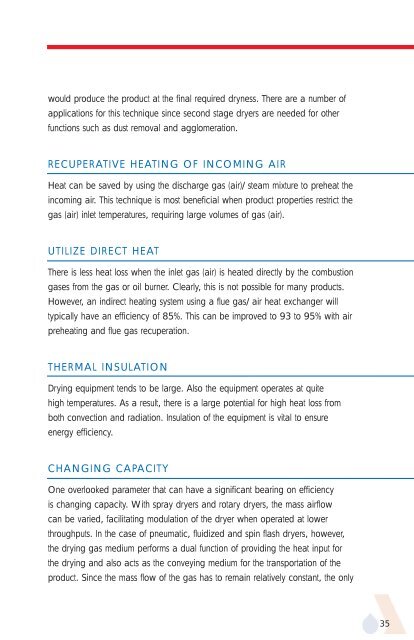APV Dryer Handbook - Umbc
APV Dryer Handbook - Umbc
APV Dryer Handbook - Umbc
Create successful ePaper yourself
Turn your PDF publications into a flip-book with our unique Google optimized e-Paper software.
would produce the product at the final required dryness. There are a number of<br />
applications for this technique since second stage dryers are needed for other<br />
functions such as dust removal and agglomeration.<br />
RECUPERATIVE HEATING OF INCOMING AIR<br />
Heat can be saved by using the discharge gas (air)/steam mixture to preheat the<br />
incoming air. This technique is most beneficial when product properties restrict the<br />
gas (air) inlet temperatures, requiring large volumes of gas (air).<br />
UTILIZE DIRECT HEAT<br />
There is less heat loss when the inlet gas (air) is heated directly by the combustion<br />
gases from the gas or oil burner. Clearly, this is not possible for many products.<br />
However, an indirect heating system using a flue gas/air heat exchanger will<br />
typically have an efficiency of 85%. This can be improved to 93 to 95% with air<br />
preheating and flue gas recuperation.<br />
THERMAL INSULATION<br />
Drying equipment tends to be large. Also the equipment operates at quite<br />
high temperatures. As a result, there is a large potential for high heat loss from<br />
both convection and radiation. Insulation of the equipment is vital to ensure<br />
energy efficiency.<br />
CHANGING CAPACITY<br />
One overlooked parameter that can have a significant bearing on efficiency<br />
is changing capacity. With spray dryers and rotary dryers, the mass airflow<br />
can be varied, facilitating modulation of the dryer when operated at lower<br />
throughputs. In the case of pneumatic, fluidized and spin flash dryers, however,<br />
the drying gas medium performs a dual function of providing the heat input for<br />
the drying and also acts as the conveying medium for the transportation of the<br />
product. Since the mass flow of the gas has to remain relatively constant, the only<br />
35











